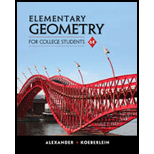
The surface of a soccer ball is composed of 12 regular pentagons and 20 regular hexagons.
With each side of each regular
a) What is the surface area of the soccer ball?
b) If the material used to construct the ball costs 0.8 of a cent per square centimeter, what is the cost of the materials used in construction?

Trending nowThis is a popular solution!

Chapter 9 Solutions
Elementary Geometry for College Students
Additional Math Textbook Solutions
Pathways To Math Literacy (looseleaf)
Elementary Statistics: Picturing the World (7th Edition)
A First Course in Probability (10th Edition)
University Calculus: Early Transcendentals (4th Edition)
Probability And Statistical Inference (10th Edition)
Graphical Approach To College Algebra
- om nearest tenth if necessary. milsum 3. છે. 9.3mm 3mm A 78-43-92 4-3) 11.7 of 72.04-11.7-= lygons 7.8 mi 60.94 blants" 9 om 6. 4.15-7 16- 32m 1.8m 4.5m % ose 4.5m as to 65m 14 represents 5 square meters.arrow_forwardThe diagonals of rhombus ABCD intersect at E. Given that BAC=53 degrees, DE=8, and EC=6 find AEarrow_forwardVolume of Dubai Cayan Towerarrow_forward
- 1 B-P P+1+ 2-p 4-p min(Red)=? y=x² A (P,P')arrow_forwardMI P X /courses/segura10706/products/171960/pages/611?locale=&platformId=1030&lms=Y ☆ Finish Part I: Mathematics for Elementary and Middle School Teachers Continue in the app JJ 576 Chapter 12. Area of Shapes 9. Determine the area of the shaded shapes in Figure 12.48. Explain your reasoning. 1 unit S Figure 12.48 1 unit unit and the yarn for thearrow_forwardChrom ESS $425 5. Ar Dive for x 21) Name 1. Classify the triangles based on their side lengths and angle measures. 89° 30° Acute Scalene Right Scalene 130° Date A +100 Obtuse Equiangular Isosceles Equilateral What additional information would you need to prove these triangles congruent by ASA? If marrow_forwardBoth find out Only 100% sure experts solve it correct complete solutions okkk don't use chat gpt or other ai okkarrow_forwardOnly 100% sure experts solve it correct complete solutions okkk don't use chat gpt or other ai okkarrow_forwardLogin HAC Home View Summary MwMerriam-Webster: A... Lizard Point Quizze... G Home | Gimkit Quizlet Live | Quizlet K! Kahoot! 7.2 HW Central Angles, Arcs, and Arc Lengths POSSIBLE POINTS: 6.67 11. If myQ=(y+7), mQR = (x+11), mRS = (3y), and mST = 65°, find the values of x and y. R V X = y = W S T q W a It N S C % 65 54 # m d DELL 96 t y 0 27 & J * 00 8 x= y= f g h J k X C V b n 3 ES 1 Feb 26 alt ctrlarrow_forwardThe three right triangles below are similar. The acute angles LL, LR, and ZZ are all approximately measured to be 66.9°. The side lengths for each triangle are as follows. Note that the triangles are not drawn to scale. Z 20.17 m 60.51 m 66.9° 7.92 m 66.9° 80.68 m 66.9° 23.76 m 31.68 m Take one 18.55 m K P 55.65 m X 74.2 m Y (a) For each triangle, find the ratio of the length of the side opposite 66.9° to the length of the hypotenuse. Round your answers to the nearest hundredth. JK JL PQ PR XY ☐ XZ (b) Use the ALEKS Calculator to find sin 66.9°, cos 66.9°, and tan 66.9°. Round your answers to the nearest hundredth. sin 66.9° = ☐ cos 66.9° tan 66.9° = ☐ (c) Which trigonometric function gives each ratio of sides in part (a)? Osine Ocosine Otangent none of thesearrow_forwardT Figure E Statement 33 33° H 40 R 37° 83° S T 55 45 K S 30 U 44 87 H 56 36 ° 54 F 83° 66 P 33 87° ° I 42 200 Rarrow_forwardStella's friends got her a skydiving lesson for her birthday. Her helicopter took off from the skydiving center, ascending in an angle of 37°, and traveled a distance of 2.1 kilometers before she fell in a straight line perpendicular to the ground. How far from the skydiving center did Stella land? Be sure to have all three parts of a CER answer: make a claim, provide evidence, and explain your reasoning for full credit. 2.1 km Landing spot 37% Skydiving centerarrow_forwardarrow_back_iosSEE MORE QUESTIONSarrow_forward_ios
 Holt Mcdougal Larson Pre-algebra: Student Edition...AlgebraISBN:9780547587776Author:HOLT MCDOUGALPublisher:HOLT MCDOUGAL
Holt Mcdougal Larson Pre-algebra: Student Edition...AlgebraISBN:9780547587776Author:HOLT MCDOUGALPublisher:HOLT MCDOUGAL Mathematics For Machine TechnologyAdvanced MathISBN:9781337798310Author:Peterson, John.Publisher:Cengage Learning,
Mathematics For Machine TechnologyAdvanced MathISBN:9781337798310Author:Peterson, John.Publisher:Cengage Learning, Elementary Geometry for College StudentsGeometryISBN:9781285195698Author:Daniel C. Alexander, Geralyn M. KoeberleinPublisher:Cengage Learning
Elementary Geometry for College StudentsGeometryISBN:9781285195698Author:Daniel C. Alexander, Geralyn M. KoeberleinPublisher:Cengage Learning Elementary Geometry For College Students, 7eGeometryISBN:9781337614085Author:Alexander, Daniel C.; Koeberlein, Geralyn M.Publisher:Cengage,
Elementary Geometry For College Students, 7eGeometryISBN:9781337614085Author:Alexander, Daniel C.; Koeberlein, Geralyn M.Publisher:Cengage, Elementary AlgebraAlgebraISBN:9780998625713Author:Lynn Marecek, MaryAnne Anthony-SmithPublisher:OpenStax - Rice University
Elementary AlgebraAlgebraISBN:9780998625713Author:Lynn Marecek, MaryAnne Anthony-SmithPublisher:OpenStax - Rice University Algebra: Structure And Method, Book 1AlgebraISBN:9780395977224Author:Richard G. Brown, Mary P. Dolciani, Robert H. Sorgenfrey, William L. ColePublisher:McDougal Littell
Algebra: Structure And Method, Book 1AlgebraISBN:9780395977224Author:Richard G. Brown, Mary P. Dolciani, Robert H. Sorgenfrey, William L. ColePublisher:McDougal Littell





